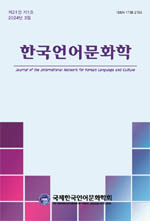한국어-베트남어 단모음 대조를 통한 난이도 위계 설정
Difficulty level setting through the contrast Korean-Vietnamese single vowel
- 국제한국언어문화학회
- 한국언어문화학
- 제15권 제2호
-
2018.0893 - 123 (31 pages)
-
DOI : 10.15652/ink.2018.15.2.093
- 4

본 연구의 목적은 지각과 산출 실험을 통해 베트남인 한국어 학습자들 이 느끼는 단모음의 난이도 위계를 설정하는 데 있다. 베트남인 학습 자들은 모국어 단모음과의 대응을 통해 비교적 한국어 단모음을 쉽게 학습한다는 것이 일반적인 견해이다. 그러나 산출 실험 결과 학습자들 은 한국인 모국어 화자보다 단모음을 산출하는 공간이 좁으며, 후설 모음에서는 한국어와 베트남어 대응 모음이 일치하지 않는다. 베트남 어에 대응하는 한국어 대응 모음은 해당 베트남어 모음보다 높은 위치 에서 발음된다. 이러한 차이가 학습자의 후설 모음 지각 오류를 불러 일으키며, 오류가 가장 많은 모음쌍은 /ㅗ/와 /ㅜ/이다. /ㅐ/는 실험 대 상에 포함되어 있지 않으나 /ㅔ/를 /ㅐ/로 지각하는 학습자도 많았다. 실험 결과 베트남 학습자들을 위한 단모음 난이도 위계는 다음과 같 다. 0단계: ㅣ, ㅏ 1단계 : ㅡ, 2단계 : ㅔ / ㅐ, 3단계 : ㅜ, ㅗ, ㅓ
This study determined the difficulty level of simple vowels for Vietnamese students of the Korean language. The prevailing view is that Vietnamese students tend to learn simple Korean vowels by comparing them to simple Vietnamese vowels. However, this study’s results show that Vietnamese students have narrower spaces for pronouncing simple vowels than Korean speakers. Thus, corresponding simple Korean vowels are placed higher than simple Vietnamese vowels. Differences thus occurred because of back–vowel perception errors; most errors occurred between /ㅗ/ and /ㅜ/, while /ㅐ/ was excluded in this experiment. Most students apperceived /ㅔ/ to /ㅐ/. Difficulty levels were thus set to the following: Level 0: ㅣ and ㅏ; Level 1: ㅡ; level 2: ㅔ and ㅐ; Level 3: ㅜ, ㅗ, and ㅓ.
1. 연구 목적과 필요성
2. 한국어와 베트남어의 단모음 음소 대조
3. 실험 설계
4. 실험 결과
5. 단모음별 음운 대조
6. 결론
참고문헌
(0)
(0)